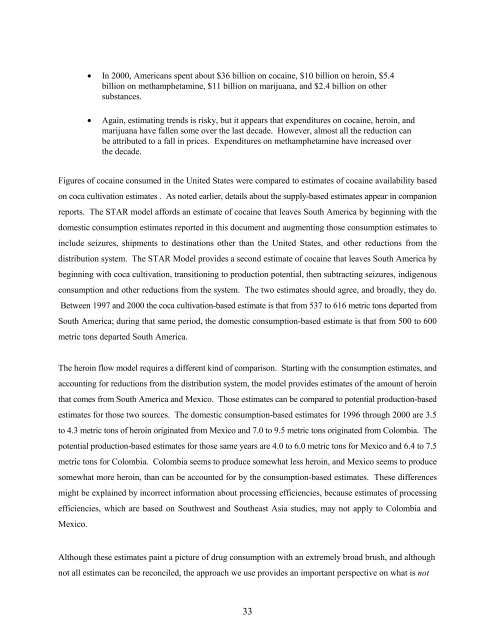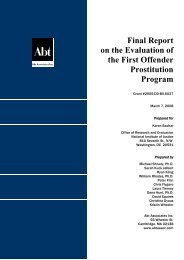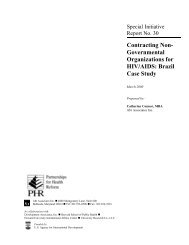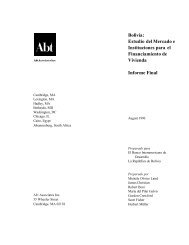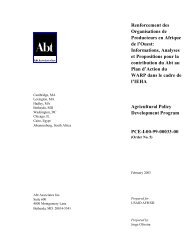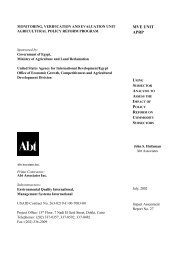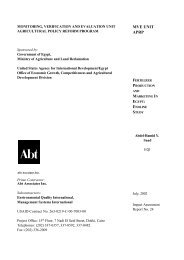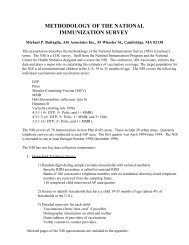What America's Users Spend on Illegal Drugs 1988-2000 - National ...
What America's Users Spend on Illegal Drugs 1988-2000 - National ...
What America's Users Spend on Illegal Drugs 1988-2000 - National ...
- No tags were found...
Create successful ePaper yourself
Turn your PDF publications into a flip-book with our unique Google optimized e-Paper software.
In <strong>2000</strong>, Americans spent about $36 billi<strong>on</strong> <strong>on</strong> cocaine, $10 billi<strong>on</strong> <strong>on</strong> heroin, $5.4billi<strong>on</strong> <strong>on</strong> methamphetamine, $11 billi<strong>on</strong> <strong>on</strong> marijuana, and $2.4 billi<strong>on</strong> <strong>on</strong> othersubstances.Again, estimating trends is risky, but it appears that expenditures <strong>on</strong> cocaine, heroin, andmarijuana have fallen some over the last decade. However, almost all the reducti<strong>on</strong> canbe attributed to a fall in prices. Expenditures <strong>on</strong> methamphetamine have increased overthe decade.Figures of cocaine c<strong>on</strong>sumed in the United States were compared to estimates of cocaine availability based<strong>on</strong> coca cultivati<strong>on</strong> estimates . As noted earlier, details about the supply-based estimates appear in compani<strong>on</strong>reports. The STAR model affords an estimate of cocaine that leaves South America by beginning with thedomestic c<strong>on</strong>sumpti<strong>on</strong> estimates reported in this document and augmenting those c<strong>on</strong>sumpti<strong>on</strong> estimates toinclude seizures, shipments to destinati<strong>on</strong>s other than the United States, and other reducti<strong>on</strong>s from thedistributi<strong>on</strong> system. The STAR Model provides a sec<strong>on</strong>d estimate of cocaine that leaves South America bybeginning with coca cultivati<strong>on</strong>, transiti<strong>on</strong>ing to producti<strong>on</strong> potential, then subtracting seizures, indigenousc<strong>on</strong>sumpti<strong>on</strong> and other reducti<strong>on</strong>s from the system. The two estimates should agree, and broadly, they do.Between 1997 and <strong>2000</strong> the coca cultivati<strong>on</strong>-based estimate is that from 537 to 616 metric t<strong>on</strong>s departed fromSouth America; during that same period, the domestic c<strong>on</strong>sumpti<strong>on</strong>-based estimate is that from 500 to 600metric t<strong>on</strong>s departed South America.The heroin flow model requires a different kind of comparis<strong>on</strong>. Starting with the c<strong>on</strong>sumpti<strong>on</strong> estimates, andaccounting for reducti<strong>on</strong>s from the distributi<strong>on</strong> system, the model provides estimates of the amount of herointhat comes from South America and Mexico. Those estimates can be compared to potential producti<strong>on</strong>-basedestimates for those two sources. The domestic c<strong>on</strong>sumpti<strong>on</strong>-based estimates for 1996 through <strong>2000</strong> are 3.5to 4.3 metric t<strong>on</strong>s of heroin originated from Mexico and 7.0 to 9.5 metric t<strong>on</strong>s originated from Colombia. Thepotential producti<strong>on</strong>-based estimates for those same years are 4.0 to 6.0 metric t<strong>on</strong>s for Mexico and 6.4 to 7.5metric t<strong>on</strong>s for Colombia. Colombia seems to produce somewhat less heroin, and Mexico seems to producesomewhat more heroin, than can be accounted for by the c<strong>on</strong>sumpti<strong>on</strong>-based estimates. These differencesmight be explained by incorrect informati<strong>on</strong> about processing efficiencies, because estimates of processingefficiencies, which are based <strong>on</strong> Southwest and Southeast Asia studies, may not apply to Colombia andMexico.Although these estimates paint a picture of drug c<strong>on</strong>sumpti<strong>on</strong> with an extremely broad brush, and althoughnot all estimates can be rec<strong>on</strong>ciled, the approach we use provides an important perspective <strong>on</strong> what is not33


